Adventures in Birdland
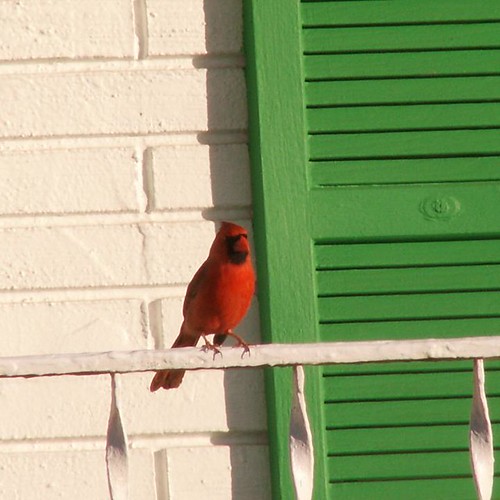
Male Northern Cardinal (Cardinalis cardinalis, Family Fringillidae). Ranges from southern Ontario to the Gulf states and southwest U.S., and Mexico to Belize. Given the colors here and the recent Olympics in Torino, I was going to title this shot, "Viva Italia!" When I checked my 2005 World Almanac and Book of Facts I discovered that green, white, and red stripes (in varying presentation order, alone or with other components) also appear in the flags of Bulgaria, Equatorial Guinea, Hungary, Iran, Kuwait, Madagascar, Mexico, Oman, Tajikistan, and the United Arab Emirates.
Weather has been perfect for our "post office walks" -- and this is the time of year when various birds begin to migrate back north, passing through this way. By my reckoning I've photographed 10 different species, all within a mile of home, over a five-day span....
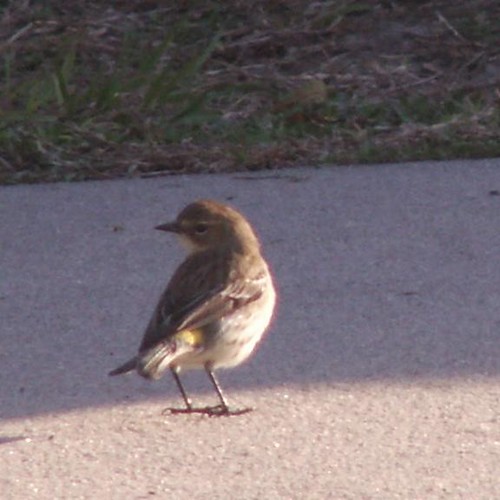
I'm guessing this is a female Yellow-Rumped Warbler (Dendroica coronata, Family Parulidae). She kindly shows off her yellow rump, which peeks out from under her wing. These birds are smaller than sparrows and range over Alaska, Canada, and the northeast U.S., wintering to Panama. A shot of another yellow-rumped warbler feeding is here.
I am less confident about the next two shots, which might be of the same species. I think I've photographed two different types of birds, but I could be wrong.
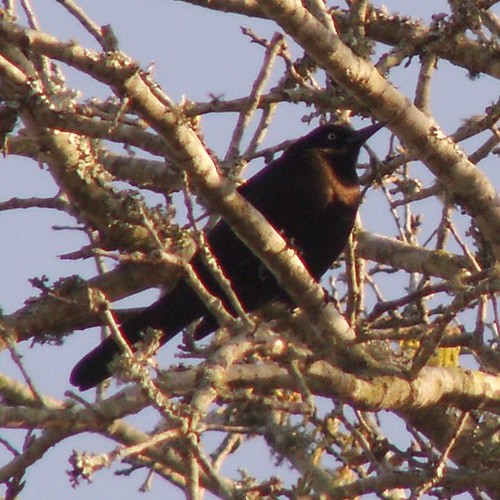
I think this is either a Rusty Blackbird (Euphagus carolinus) or a Brewer's Blackbird (Euphagus cyanocephalus), Family Icteridae. Either can winter here, though we're right at the edge of the Brewer's range. I'm guessing this is a rusty. "Suggests a short-tailed grackle," says Peterson's Field Guide to the Birds of Eastern and Central North America -- and in fact when I first photographed this bird I thought it was a grackle until I downloaded the shot. Ranges from Alaska and Canada to the northeast edge of the U.S., down to the southeast U.S.
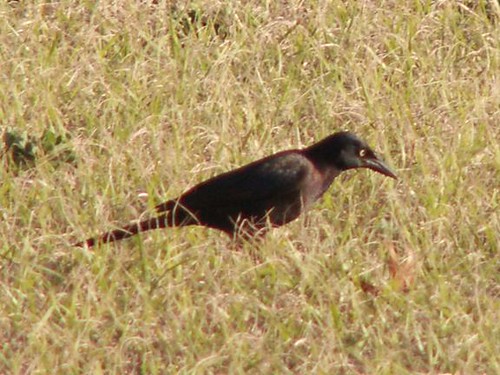
This is what I think is a Grackle (Quiscalus quiscula, Family Icteridae), mainly because of the grackle's larger size and longer beak. If I could see the breadth of its tail I would know for certain -- a wedge-shaped tail would tell me my guess is right. This would be a member of the "purple race" seen on the eastern seaboard south of New England, in contrast to the "bronze race" I saw quite often in Massachusetts. (The two types of grackles were once thought to be separate species.)

On our way home from the post office Mary and I passed a group of trees teeming with very vocal American Robins. (Turdus migratorius, Family Turdidae). The air was filled with their flight traffic. Two days later we came across a flock bathing at the "post office pond".
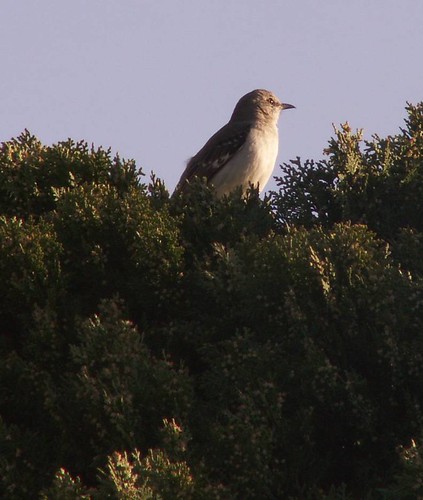
The Northern Mockingbird (Mimus polyglottos, Family Mimidae) is Florida's state bird and is a protected species here. We were lucky enough to have a brood nesting in our front hedge the summer of 2003. Says Florida Gardener, "Senate Concurrent Resolution No.3 of the 1927 legislative session designated the mockingbird as the State Bird. Not only a Florida favorite, it is the State Bird of Arkansas, Mississippi, Tennessee and Texas."
This little one is immature and perched at the very top of a neighbor's tall arborvitae. It made some plaintive cries as we passed by -- perhaps for food, or to get somebody to move those big, two-footed creatures below out of the way.
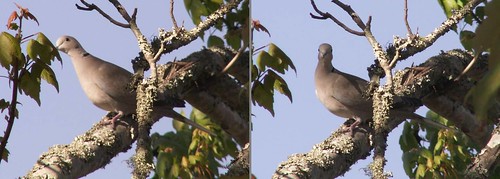
Eurasian Collared Dove (Streptopelia decaocto, Family Columbidae). I originally thought this was a ringed turtle dove, but thanks to another photographer I took a closer look at the shot (the Eurasian collared dove is not mentioned in Peterson's). The dark tips on its primary feathers decided me. Birdsource.org has a good guide on how to tell the difference between the two species; and an impressive animated map that shows how the collared dove has expanded in numbers, mainly in Florida, during Christmas bird counts from 1987 through 1997.
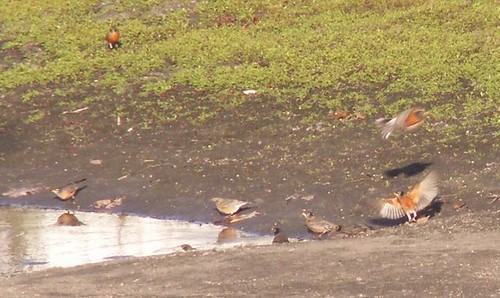
Our "post office pond" was teeming with birds, mostly robins. Here the male at right makes a splendid show of his wings while another male flies over. A video of the birds enjoying a spirited bath (43 seconds, 16+ MB) is here. (I had to use the library's DSL connection to confirm I'd uploaded the video correctly, and even then I had to wait a few minutes for it to load. My dial-up connection at home was fairly overwhelmed.)
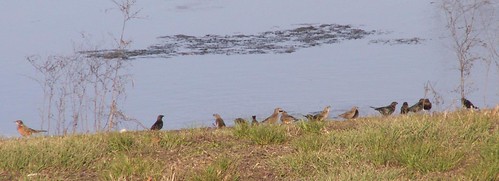
The bird at far left is a male robin, but the others here all seem to be Brown-headed Cowbirds (Molothrus ater, Family Icteridae), a type of blackbird. The darker ones are males. Another shot, showing a couple of male cowbirds in flight among a crowd of robins, is here.
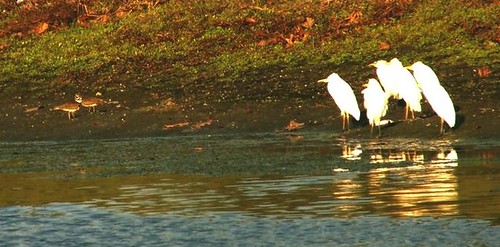
A half-dozen cattle egrets on the right take note of a pair of killdeer on the left. I'd been driving home from a meeting; a quick glance at the pond from the road told me the egrets were there. I'd seen the killdeer before but was too far away each time to get a decent shot of them. This time I parked in the strip mall lot across from the post office and walked several blocks back to the pond, then advanced slowly down a spillway. I got as close as I could on the opposite bank before I started snapping away.
Cattle Egrets (Bubulcus ibis, Family Ardeidae) range across southern Eurasia and migrated to the Americas in 1952, as well as to Australia. They have been introduced into Hawaii as well.
Killdeer (Charadrius vociferus, Family Charadriidae) are distinguishable from other plovers because they have two black breastbands instead of one. They range from Canada to central Mexico and across the West Indies and coastal Peru. "Migrant in North," says the Peterson -- and indeed, I saw my first killdeer (that I recognized as such) in Massachusetts. During the months of August and September, the shores of Dorchester Bay became home to plovers winging their way south for the winter. A series of killdeer shots with a better view of their breastbands is here.
Every so often our camera club holds a competition, and I've finally checked out the local resources for obtaining and matting/framing prints. This month's competition is "Water" -- and I'll be entering "Water Ballet" and "Sun Catchers". It's the first time I've entered photos into a competition, so I'll be interested to see how they do. A local judge gives each entry a critique.
If all goes according to schedule, our honeysuckle in the front yard should see some hummingbirds in a few weeks.











2 Comments:
A walk to the post office heralded some beautiful winged delights! Love these photos... especially from our still Wintery vantage up here in Canada.
The cardinal almost looks posed. We just got back from camping at the ocean in South Carolina. The pelicans look like cartoon characters!
Post a Comment
<< Home